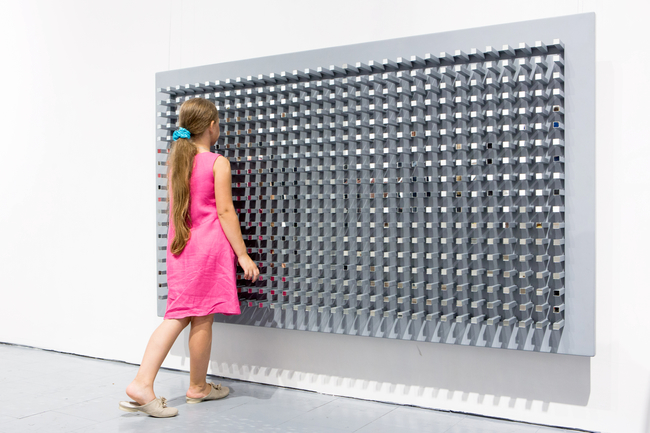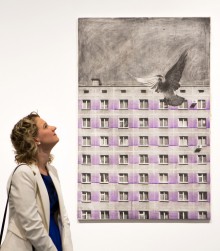The vernissage of the Vilnius-based TSEKH has a symbolical title – “Leap to Europe.” This is a representational project which displays works by all of the resident artists of the gallery.
An hour before the opening, which took place on July 23, one could see people with buckets of paint and equipment wandering in the premises of the Lithuanian TSEKH – “CEHAS VILNIUS” – and hear fragments of jazz melodies, as the musicians were rehearsing. It was hard to stay aside of this impulse of collective work, so I found a task for myself as well: I cut out of paper the titles of the works and glued then to the plaques. Although some details are finished at the last moment, it has taken a lot of time to prepare for the opening of the Vilnius branch of TSEKH, both in Ukraine, and Vilnius.
FIRST EXPOSITION
The opening of the exhibition “Leap to Europe” was by far the first time when the resident artists of the gallery gathered together: Mykola Bilous, Yaroslav Derkach, Rustam Mirzoiev, Serhii Oleksiuk, Yevhen Petrov, and VALYA. All of them are Ukrainian artists, who, although they are residing in different places, from Kolomyia to California. The works are dated 2010s; three of them, Forest by Mykola Bilous, Sunday/Resurrection by Rustam Mirzoiev, and City Rain by Serhii Oleksiuk, were created purposefully for the first exhibit in Lithuania.
Interestingly, the art works became “participants” of the opening event. During the official ceremony people were delivering speeches from Podium, which is a work by Yaroslav Derkach, a sports pedestal with figures 4, 5, 6 inscribed on it. A bit later, when the guests got adapted to the space, little girls were swinging on a huge rope, actually a work by VALYA – Nice surprise. Lyndyk.

THE WORK CITY RAIN BY SERHII OLEKSIUK RESEMBLES A HUGE MIRROR WITH HUNDREDS OF DROPS ON IT
The emerging of the Ukrainian gallery in Vilnius was supported by the municipal authorities of the city and even the Minister of Foreign Affairs of the Baltic State Linas Linkevicius. At the opening event, the Ambassador Extraordinary and Plenipotentiary of the Lithuanian Republic to Ukraine Marius Yanukonis noted: “For diplomats it is always very pleasant when there is more of Lithuania in Ukraine, and vice versa. I am glad that this project emerged, uniting our capitals and our people.”
THE SPACE
The premises of TSEKH in Vilnius are practically a twin of the Kyiv gallery. The minimalism, high white walls, and small first floors are present in both venues. In Vilnius, TSEKH rents the premises in the Vilnius Classics Theater. The building in Vytenio Street, which is, incidentally, located next to Taras Shevchenko Street, was built in the 1930s, at first was supposed to serve as a Polish Catholic church.
“After the Soviet Union came, a House of Culture of Builders was opened here, later it housed a bowling club. But the premises allotted for us have been empty since 1990, it was called a cold room,” Oleksandr SHCHELUSHCHENKO, the founder of the TSEKH, says. In the future a theater and probably a concert hall will be established in the same building – this will be a kind a culture center.
The space was prepared for the opening by over 30 people: builders, designers, constructors, welders, plasterers, and artists. The latter not only watched how their works will be arranged, but even helped to clean, paint, and generally to bring the premises to order in every way.
A STORY
A great role in bringing the Ukrainian gallery to Lithuania was played by Arturas Zuokas. He is a symbolical personality for Lithuania. Arturas was three times the mayor of Vilnius, the youngest in his time (for the first time he took the office at the age of 32), he has done a lot for revitalization of the abandoned premises of the city, was among the initiators of the reviving of formerly criminal neighborhood of Uzupis, turning it into a prestigious one.
“We started to discuss the idea of creating the gallery TSEKH in Vilnius over two years ago. Oleksandr knows how to win the Lithuanian politicians. He said that in the time of the Grand Duchy of Lithuania Vilnius was the capital of Ukrainian lands too, so a tribute should be paid to the city. I think for every Lithuanian it sounds like a serenade,” Arturas Zuokas laughs. “Besides, I am very glad it has been held.”
Generally, TSEKH which opened in Kyiv Podil in 2005 had connections with Lithuania from the first years of its existence. In 2007 the Lithuanian attache for culture Gabriele Zaidyte liked the space of the gallery and proposed to Oleksandr Shchelushchenko to hold a few Baltic projects there. The idea was realized, and then the gallery was invited to present its artists in Vilnius.
TSEKH has taken part in the International Contemporary Art Fair “ArtVilnius” for six times. “For the first time I was invited to this event by curator of ArtVilnius Raminta Jurenaite, who is very influential in Lithuania. She came to Kyiv, visited our exhibit, and invited us to the fair after that,” Shchelushchenko recalls, “In Lithuania we had wonderful conditions for presentation and over the years of participation in ArtVilnius we have won many awards. We have been named the best foreign gallery, and our artist Mykola Bilous was named the best foreign artist.”
AFTERWORD
Oleksandr Shchelushchenko is currently working in two capitals. He has plenty of plans. “Lithuania is very close to us. Over eight years that I have been visiting Vilnius on a regular basis, I have never felt lonely or unneeded here,” the gallerist admits. “Probably, our artists will look here a bit different, sharper, but we would like to remain a Ukrainian gallery in Lithuania for as long as it is possible, preserve this image, and fill Vilnius with other culture experiences. Our home is Kyiv though. But I dream that our gallery in Vilnius will be successful and that many interesting adventures await us here.”







